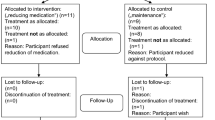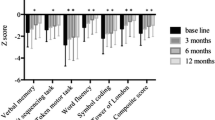Abstract
Objective of this observational trial is to examine the effects of quetiapine in comparison with olanzapine and risperidone on clinical outcomes and quality of life in patients with schizophrenia and schizoaffective disorder in routine care. 374 adult persons with schizophrenia or schizoaffective disorder prescribed antipsychotic maintenance therapy with quetiapine, olanzapine, or risperidone at discharge from inpatient treatment were included. Clinical and psychosocial outcomes were assessed before discharge and at 6, 12, 18, and 24 months. Statistical analyses were conducted by mixed-effects regression models for longitudinal data. The propensity score method was used to control for selection bias. Patients discharged on olanzapine had significantly lower hospital readmissions than those receiving quetiapine or risperidone. The average chlorpromazine equivalent dose of quetiapine was higher than in patients treated with olanzapine or risperidone. No further significant differences between treatment groups were found. Quetiapine and risperidone are less effective in preventing the need for psychiatric inpatient care than olanzapine, and higher chlorpromazine equivalent doses of quetiapine are needed to obtain clinical effects similar to those of olanzapine and risperidone.



Similar content being viewed by others
References
Komossa K, Rummel-Kluge C, Schmid F et al (2010) Quetiapine versus other atypical antipsychotics for schizophrenia. Cochrane Database Syst Rev (1):CD006625
Rummel-Kluge C, Komossa K, Schwarz S et al (2010) Second-generation antipsychotic drugs and extrapyramidal side effects: a systematic review and meta-analysis of head-to-head comparisons. Schizophr Bull
Dossenbach M, Pecenak J, Szulc A et al (2008) Long-term antipsychotic monotherapy for schizophrenia: disease burden and comparative outcomes for patients treated with olanzapine, quetiapine, risperidone, or haloperidol monotherapy in a pan-continental observational study. J Clin Psychiatry 69(12):1901–1915
Dossenbach M, Dyachkova Y, Pirildar S et al (2006) Effects of atypical and typical antipsychotic treatments on sexual function in patients with schizophrenia: 12-month results from the intercontinental schizophrenia outpatient health outcomes (IC-SOHO) study. Eur Psychiatry 21(4):251–258
Dossenbach M, Erol A, el Mahfoud KM et al (2004) Effectiveness of antipsychotic treatments for schizophrenia: interim 6-month analysis from a prospective observational study (IC-SOHO) comparing olanzapine, quetiapine, risperidone, and haloperidol. J Clin Psychiatry 65(3):312–321
Swartz MS, Stroup TS, McEvoy JP et al (2008) What CATIE found: results from the schizophrenia trial. Psychiatry Serv 59(5):500–506
Stroup TS, Lieberman JA, McEvoy JP et al (2007) Effectiveness of olanzapine, quetiapine, and risperidone in patients with chronic schizophrenia after discontinuing perphenazine: a CATIE study. Am J Psychiatry 164(3):415–427
Lieberman JA, Stroup TS, McEvoy JP et al (2005) Effectiveness of antipsychotic drugs in patients with chronic schizophrenia. N Engl J Med 353(12):1209–1223
de Arce CR, Eding E, Marques-Teixeira J et al (2011) Descriptive analyses of the aripiprazole arm in the risperidone long-acting injectable versus quetiapine relapse prevention trial (ConstaTRE). Eur Arch Psychiatry Clin Neurosci. doi:10.1007/s00406-011-0220-8
Johnsen E, Kroken RA, Wentzel-Larsen T et al (2010) Effectiveness of second-generation antipsychotics: a naturalistic, randomized comparison of olanzapine, quetiapine, risperidone, and ziprasidone. BMC Psychiatry 10:26
Moller HJ (2011) How close is evidence to truth in evidence-based treatment of mental disorders? Eur Arch Psychiatry Clin Neurosci. doi:10.1007/s00406-011-0273-8
Kay SR, Opler LA, Lindemeyer JP (1989) The positive and negative syndrome scale (PANSS): rationale and standardisation. Br J Psychiatry 155:59–65
American Psychiatric Association (2000) Diagnostic and statistical manual of mental disorders, 4th edn, Text Revision edn. American Psychiatric Association, Washington
Simpson G, Angus J (1970) A rating scale for extrapyramidal side effects. Acta Psychiatry Scand 212:11–19
Lane RD, Glazer WM, Hansen TE et al (1985) Assessment of tardive dyskinesia using the abnormal involuntary movement scale. J Nerv Ment Dis 173(6):353–357
Gaite L, Vázquez-Barquero JL, Arraiga Arrizabalaga A et al (2000) Internal consistency of the Lancashire quality of life profile—EU version (LQoLP-EU) EPSILON study 8. Br J Psychiatry 39(suppl):s49–s54
Thompson K, Kulkarni J, Sergejew AA (2000) Reliability and validity of a new medication adherence rating scale (MARS) for the psychoses. Schizophr Res 42(3):241–247
Kaufman A, Lichtenberger E (2002) Assessing adolescent and adult intelligence. Wiley, Hoboken
Chisholm D, Knapp M, Knudsen HC et al (2000) Client sociodemographic and service receipt inventory-European version. Br J Psychiatry 177(suppl. 39):S28–S33
Andreasen NC, Pressler M, Nopoulos P et al (2010) Antipsychotic dose equivalents and dose-years: a standardized method for comparing exposure to different drugs. Biol Psychiatry 67(3):255–262
Gardner DM, Murphy AL, O’Donnell H et al (2010) International consensus study of antipsychotic dosing. Am J Psychiatry 167(6):686–693
Swanson JM, Hinshaw SP, Arnold LE et al (2007) Secondary evaluations of MTA 36-month outcomes: propensity score and growth mixture model analyses. J Am Acad Child Adolesc Psychiatry 46(8):1003–1014
Kilian R, Angermeyer MC (2005) The effects of antipsychotic treatment on quality of life of schizophrenic patients under naturalistic treatment conditions: an application of random effect regression models and propensity scores in an observational prospective trial. Qual Life Res 14:1275–1289
D’Agostino RB (1998) Tutorial in biostatistics. Propensity score methods for bias reduction in the comparison of a treatment to a non-randomized control group. Stat Med 17:2265–2281
Greene WH (2003) Econometric analysis, 5th edn. Prentice Hall, Upper Saddle River
Erdfelder E, Buchner A, Faul F et al (2004) GPower Teststärkeanalysen leicht gmeacht. In: Erdfelder E, Funke J (eds) Allgemeine Psychologie und Deduktivistische Methodologie. Vandenhoeck & Ruprecht, Göttingen, pp 148–166
Barbui C, Nose M, Mazzi MA et al (2006) Persistence with polypharmacy and excessive dosing in patients with schizophrenia treated in four European countries. Int Clin Psychopharmacol 21(6):355–362
Constantine RJ, Andel R, Tandon R (2010) Trends in adult antipsychotic polypharmacy: progress and challenges in Florida’s Medicaid program. Community Ment Health J
Messer T, Tiltscher C, Schmauss M (2006) Polypharmacy in the treatment of schizophrenia. Fortschr Neurol Psychiatry 74(7):377–391
Mojtabai R, Olfson M (2010) National trends in psychotropic medication polypharmacy in office-based psychiatry. Arch Gen Psychiatry 67(1):26–36
Procyshyn RM, Honer WG, Wu TK et al (2010) Persistent antipsychotic polypharmacy and excessive dosing in the community psychiatric treatment setting: a review of medication profiles in 435 Canadian outpatients. J Clin Psychiatry 71(5):566–573
Rupnow MF, Greenspan A, Gharabawi GM et al (2007) Incidence and costs of polypharmacy: data from a randomized, double-blind, placebo-controlled study of risperidone and quetiapine in patients with schizophrenia or schizoaffective disorder. Curr Med Res Opin 23(11):2815–2822
Zink M, Englisch S, Meyer-Lindenberg A (2010) Polypharmacy in schizophrenia. Curr Opin Psychiatry 23(2):103–111
Acknowledgments
The ELAN study was funded as an investigator-initiated research project by a grant from AstraZeneca Deutschland to the University of Tübingen (Project Nr. 229/2004V—Version 2, 27.09.04). AstraZeneca had no role in the development of the research questions, the design of the study, the collection, analyses and interpretation of data, and the writing of the manuscript. AstraZeneca had the right to comment on the final draft of the article before the submission to the journal. We wish to thank all participants who participated in the study. In addition, we thank Max Schmauß, Jochen Bügler, and Frank Schwärzler for supporting the patient recruitment. We also thank Heike Wiesner, Filiz Özfirat, Tanja Gieselmann, and Simone Triem for data collection and data entry and Ildiko Baumgartner for her work in processing data. We also thank Juan Valdes-Stauber for his advice in computing CPZEQ equivalent dosages.
Conflict of interest
The authors have no conflict of interest.
Author information
Authors and Affiliations
Corresponding author
Electronic supplementary material
Below is the link to the electronic supplementary material.
Rights and permissions
About this article
Cite this article
Kilian, R., Steinert, T., Schepp, W. et al. Effectiveness of antipsychotic maintenance therapy with quetiapine in comparison with risperidone and olanzapine in routine schizophrenia treatment: results of a prospective observational trial. Eur Arch Psychiatry Clin Neurosci 262, 589–598 (2012). https://doi.org/10.1007/s00406-012-0316-9
Received:
Accepted:
Published:
Issue Date:
DOI: https://doi.org/10.1007/s00406-012-0316-9




